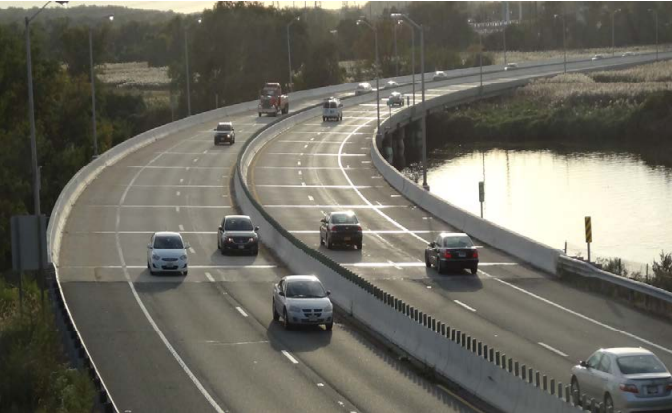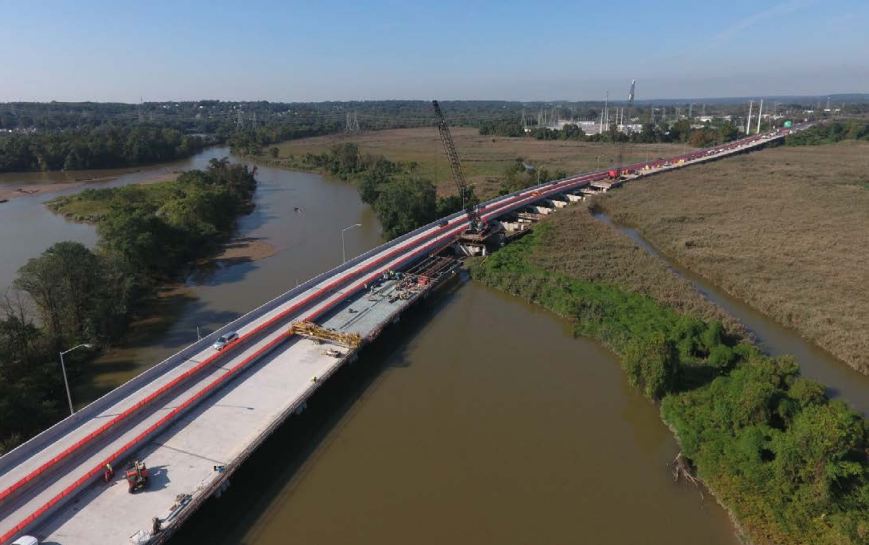The partially filled concrete grid bridge is a crucial component of the solution for the Maryland Transportation Authority’s rebuilding of the lightweight superstructure on I-895 across the Patapsco River Flats (MDTA). The project delivery system chosen for this project was Design-Bid-Build, a standard method used by owners to appoint a designer to develop a design to replace the superstructure. The selected designer for this project was Rummel, Klepper & Kahl LLP of Baltimore, who designed the replacement of the superstructure to the owner’s specifications (RK&K, 2022). After the design was approved, the MDTA issued a tender for contractors to bid for the construction work. After a thorough review of the bids, it was decided that McLean Contracting Company of Glen Burnie would be awarded the contract for the construction of the bridge deck. The structure of the bridge deck is an integral part of the superstructure replacement project, and its successful completion will be a significant milestone for the MDTA.

From the bridge deck, all work is being done. In the first phase, northbound traffic was diverted to the southbound spans and directed into a single lane with two lanes for bidirectional traffic. The project involves the replacement of the superstructure of the bridge, covering an area of roughly 177,000 sq ft (RK&K, 2020). It makes use of galvanized grid deck panels provided by Pittsburgh-based BGFMA-certified fabricator L.B. Foster. The superstructure is made up of two-span continuous pieces that are roughly 110 feet long and are separated by a strip seal expansion joint (RK&K, 2020). Through this design consistency, one unit at a time can be replaced by McLean before moving on to the next. This project will also require specialized equipment and materials to ensure the bridge’s integrity remains intact during the replacement process.
The project delivery system had specific issues and advantages; the owner was the appointing authority. This gives the owner a sense of control and security over the project. Still, it also means the process of appointing a designer and allowing the bidding process to commence is lengthy, and there is a risk of delays or budget overruns. An alternative to this is the Design-Bid-Build process, which allows the owner to select from a broad array of experienced and qualified contractors, thus guaranteeing the best possible outcome for the project. The increased pool of contractors, who have already been vetted to ensure they possess the requisite qualifications. It also allows the owner to make their selection with confidence and peace of mind, as well as the assurance that all potential issues can be addressed in a timely and professional manner.
In conclusion, the findings of this case study demonstrate the importance of developing a comprehensive strategy for managing data in order to ensure the successful implementation and maintenance of an effective data management system. By implementing a data management system, organizations can improve their ability to store, access, and analyze their data to make informed decisions and maximize their operational efficiency. Additionally, the findings of this case study indicate that organizations should ensure that their data management systems are secure, compliant, and up to date in order to ensure the highest level of data security and prevent data breaches. By following these guidelines, organizations can ensure that their data is managed effectively and efficiently.
The project delivery system chosen for the superstructure replacement had a few issues and advantages. One of the main advantages of this type of project delivery system is that it gives the owner a sense of control and security over the project, as the owner is the appointing authority. This gives the owner the privilege to assess each potential contractor, select the one that best meets their specific requirements, and provide peace of mind that any potential issues can be promptly and professionally addressed.
Furthermore, the owner has the ability to keep track of the progress of the project, ensuring that the timeline is adhered to and that the project is carried out to the highest standards. In addition, the owner can monitor the costs associated with the project, ensuring that the budget is not exceeded and that the project is completed within the estimated timeframe. All these factors combined assure the owner that their project is in safe hands (RK&K, 2020). Additionally, Design-Bid-Build offers a more extensive selection of experienced and qualified contractors to choose from, ensuring the best possible outcome for the project.

However, there are some risks associated with this type of project delivery system. The process of appointing a designer and allowing the bidding process to commence is lengthy, and there is a risk of delays or budget overruns. Moreover, there may also be a need for better communication between the appointed designer and the client as the project progresses, leading to further delays and potential disagreements. In addition, if the appointed designer or contractor is not experienced enough, there is a risk that the project will not be completed on time or to the desired specifications. Furthermore, if the appointed designer or contractor fails to adhere to the applicable laws and regulations, there is a risk of potential fines or other legal repercussions. As a result, clients must choose a designer or contractor with the necessary expertise, qualifications and experience to ensure the successful completion of the project.
Environmental issues are a significant concern when using a project delivery system such as Design-Bid-Build. The construction process itself can have a significant effect on the environment. As such, it is essential to consider the project’s potential environmental impact before starting the work. This includes evaluating the potential consequences of the materials used in the construction and the potential for air and water pollution. Moreover, it is essential to implement proper waste management practices to guarantee that any waste generated during the construction process is disposed of appropriately and responsibly. Additionally, the type of machinery and equipment used in the construction should be taken into account, as some models may be more energy-efficient and produce fewer emissions than others. Furthermore, it is also essential to ensure that any materials used are recycled whenever possible in order to reduce the level of waste produced and minimize the project’s environmental impact.
The potential environmental issues associated with the partially filled concrete grid bridge deck project should be considered, as they may have far-reaching consequences in the future. For example, using specific materials and equipment in construction may result in air and water pollution, which can negatively affect the environment and public health. In addition, the improper disposal of waste generated during the construction process could lead to the contamination of local soil and water sources, resulting in long-term negative impacts on the environment. Additionally, using specific energy-inefficient machinery and equipment in the construction process could contribute to releasing harmful gases into the atmosphere, which could lead to climate change and other environmental concerns. As such, it is essential to ensure that the materials used in the construction process are correctly disposed of and that the machinery and equipment used are energy-efficient and produce fewer emissions. By taking the necessary precautions and implementing the appropriate measures, the potential environmental impacts associated with the project can be minimized, and any future harm avoided.
It is essential to consider the potential health and safety risks associated with the project. As the construction process can be hazardous, it is imperative to guarantee that all workers and contractors receive the appropriate safety training and are provided with the appropriate safety equipment in order to reduce the chances of any potential accidents or injuries. Moreover, it is essential to take the necessary steps to make sure that the area surrounding the construction site is secure, as there may be risks posed to any unauthorized personnel that is present in the vicinity. It is essential to ensure that all safety protocols are adhered to and that any warnings or signs present are taken into account. This will ensure that all workers, contractors, and visitors to the site are aware of the potential dangers.
In conclusion, the project delivery system chosen for the superstructure replacement had a few issues and advantages. While this type of project delivery system can provide a sense of control and security to the owner, it is essential to note that there are potential delays or budget overruns. Additionally, this type of project delivery system requires careful consideration of the potential environmental, health, and safety risks associated with the project. It is essential to take the necessary precautions and implement the appropriate measures to ensure that these risks are minimized and that the project is completed safely and efficiently. This could involve conducting a thorough risk assessment of the project, ensuring that all safety protocols are followed, and maintaining regular communication with all stakeholders involved in the project. Doing so can ensure that the project is completed on time and within budget while minimizing any potential health, safety, and environmental risks.
The critical project delivery partners for the partially filled concrete grid bridge deck project are the Maryland Transportation Authority (MDTA) as the owner, Rummel, Klepper & Kahl LLP (RK&K) of Baltimore as the designer, L.B. Foster of Pittsburgh as the BGFMA-certified fabricator, and McLean Contracting Company of Glen Burnie as the construction contractor. The MDTA is the appointing authority and is responsible for selecting the designer and the contractor who will be responsible for successfully completing the project. RK&K is responsible for designing the superstructure replacement to the owner’s specifications, while L.B. Foster provides the galvanized grid deck panels required for the project. Lastly, McLean Contracting Company is responsible for constructing the bridge deck, which involves removing and installing the superstructure and utilizing specialized equipment and materials. All of these key project delivery partners are essential in ensuring the successful completion of the project, and it is vital that they all work together to ensure the superstructure replacement is done correctly and to the highest standards.
References
Pines, W. N., Healy, R. J., & Kodkani, S. S. (2019). Lightweight superstructure replacement of MDTA’s Patapsco River flats bridge. ABC-UTC Monthly Webinar.
RK&K. (2020). Patapsco flats bridge superstructure replacement. Web.
RK&K. (2022).About Us. Web.